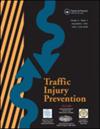An evaluation of front seat distance from rear facing child restraint systems in prevention of injury in frontal crash tests
IF 1.9
3区 工程技术
Q3 PUBLIC, ENVIRONMENTAL & OCCUPATIONAL HEALTH
引用次数: 0
Abstract
Objectives
Elevated head injury incidence in infants compared to toddlers involved as occupants in motor vehicle crashes has been demonstrated in multiple population-representative crash databases. Further, experimental studies have revealed a potential injury mechanism via impact between a rear-facing, CRS-restrained child and the back of the vehicle seat or console on the row in front of the CRS. Subsequently, experimental studies have suggested that bracing the CRS against the seat immediately in front of the CRS could mitigate head injury, but also indicated that more research was necessary. Thus, we investigated the effect of bracing against the front seat, as well as distance from the front seat with rear-facing infant carriers and rear-facing convertibles, with a focus on changes to measured head, neck and chest injury metrics in rear facing CRSs. Further, we examined the effect of using the infant carrier with and without a base on these injury metrics.
Methods
34 frontal sled tests at 30 or 35 mph were conducted using a simulated rear-row vehicle seat and structure representing the front seatback. A Q1.5 anthropomorphic test device (ATD) was placed in a single make/model LATCH-affixed rear-facing convertible or single make/model infant carrier; infant carrier without base was affixed with lap and shoulder belt. To evaluate the effect of bracing and distance, tests were conducted with a 300, 140, 70, or 15 mm gap between the CRS seatback and the front seatback, or a touching (0 mm) or braced (-20 mm) condition. Bayesian regression models quantified the effects of various predictors and model uncertainty.
Results
For tests with the convertible CRS, no head contact was observed between the head and the front vehicle seatback. For the infant carrier, head contact occurred at both 70 and 140 mm distances but not the other distances. On average, the −20, 0, or 15 mm distances yielded a 60% reduction in head injury criterion with 15 millisecond window (HIC15), and a 60% to 80% reduction in neck tension, compared to the 70 and 140 mm distances; chest acceleration also decreased for the convertible seat only. In the case of both carriers and convertibles, each mm of distance the CRS moves away from the front seatback up to 70 mm, adds 5.3 HIC15 points (95% Credible Interval (CrI):[4.6, 6.2]), and 3.5 Newtons (95% CrI: [2.2, 4.8]) of neck tension, on average.
Conclusions
Placing a rear facing CRS, both convertibles and infant carriers, against or close to the seatback of the seat immediately in front of the CRS reduces head and tensile neck injury criteria in ATDs. The amount of gap between the front seat and the rear facing CRS is strongly and positively correlated with HIC for both convertibles and infant carriers. RF infant carriers with and without a base yield comparable injury metrics and kinematics when touching or nearly touching the back of the front vehicle seatback.
评估前排座椅与后排儿童约束系统的距离,以防止正面碰撞测试中的伤害。
目的:多个具有人口代表性的碰撞数据库显示,在机动车碰撞事故中,婴儿头部受伤的发生率高于幼儿。此外,实验研究还揭示了一种潜在的受伤机制,即后向、使用儿童座椅安全系统(CRS)约束的儿童与汽车座椅后部或儿童座椅安全系统前一排的控制台之间的撞击。随后的实验研究表明,将儿童安全座椅支撑在紧靠儿童安全座椅前方的座椅上可减轻头部伤害,但同时也指出有必要开展更多研究。因此,我们研究了靠前座椅支撑的效果,以及后向婴儿背袋和后向敞篷车与前座椅的距离,重点是后向 CRS 中头部、颈部和胸部受伤测量指标的变化。此外,我们还研究了使用带底座和不带底座的婴儿背袋对这些伤害指标的影响。方法:使用模拟后排汽车座椅和代表前排座椅靠背的结构,以 30 或 35 英里/小时的速度进行了 34 次正面雪橇测试。将一个Q1.5拟人测试装置(ATD)放置在一个单一品牌/型号的LATCH固定后向敞篷车或单一品牌/型号的婴儿背架上;不带底座的婴儿背架则使用腹带和肩带固定。为了评估支撑和距离的影响,在CRS座椅靠背和前排座椅靠背之间有300、140、70或15毫米间隙的情况下,或在接触(0毫米)或支撑(-20毫米)的情况下进行了测试。贝叶斯回归模型量化了各种预测因素和模型不确定性的影响:在使用可折叠 CRS 进行的测试中,没有观察到头部与前排座椅靠背接触。对于婴儿背袋,在 70 毫米和 140 毫米的距离上都有头部接触,而在其他距离上则没有。与 70 毫米和 140 毫米的距离相比,-20 毫米、0 毫米或 15 毫米的距离平均可使 15 毫秒窗口(HIC15)的头部伤害标准降低 60%,颈部张力降低 60% 至 80%;仅可转换座椅的胸部加速度也有所降低。在承载式和敞篷式两种情况下,CRS 与前座椅靠背的距离每增加 70 毫米,HIC15 就增加 5.3 个点(95% 可信区间 (CrI):[4.6, 6.2]),颈部张力平均增加 3.5 牛顿(95% 可信区间 (CrI):[2.2, 4.8]):结论:将后向CRS(包括敞篷车和婴儿背袋)放在紧靠或靠近CRS前方座椅的椅背上,可降低ATD中的头部和颈部拉力伤害标准。对于敞篷车和婴儿背袋而言,前排座椅与后排CRS之间的间隙大小与HIC呈强正相关。带底座和不带底座的射频婴儿背袋在接触或几乎接触前排座椅靠背时产生的伤害指标和运动学效果相当。
本文章由计算机程序翻译,如有差异,请以英文原文为准。
求助全文
约1分钟内获得全文
求助全文
来源期刊

Traffic Injury Prevention
PUBLIC, ENVIRONMENTAL & OCCUPATIONAL HEALTH-
CiteScore
3.60
自引率
10.00%
发文量
137
审稿时长
3 months
期刊介绍:
The purpose of Traffic Injury Prevention is to bridge the disciplines of medicine, engineering, public health and traffic safety in order to foster the science of traffic injury prevention. The archival journal focuses on research, interventions and evaluations within the areas of traffic safety, crash causation, injury prevention and treatment.
General topics within the journal''s scope are driver behavior, road infrastructure, emerging crash avoidance technologies, crash and injury epidemiology, alcohol and drugs, impact injury biomechanics, vehicle crashworthiness, occupant restraints, pedestrian safety, evaluation of interventions, economic consequences and emergency and clinical care with specific application to traffic injury prevention. The journal includes full length papers, review articles, case studies, brief technical notes and commentaries.
 求助内容:
求助内容: 应助结果提醒方式:
应助结果提醒方式:


